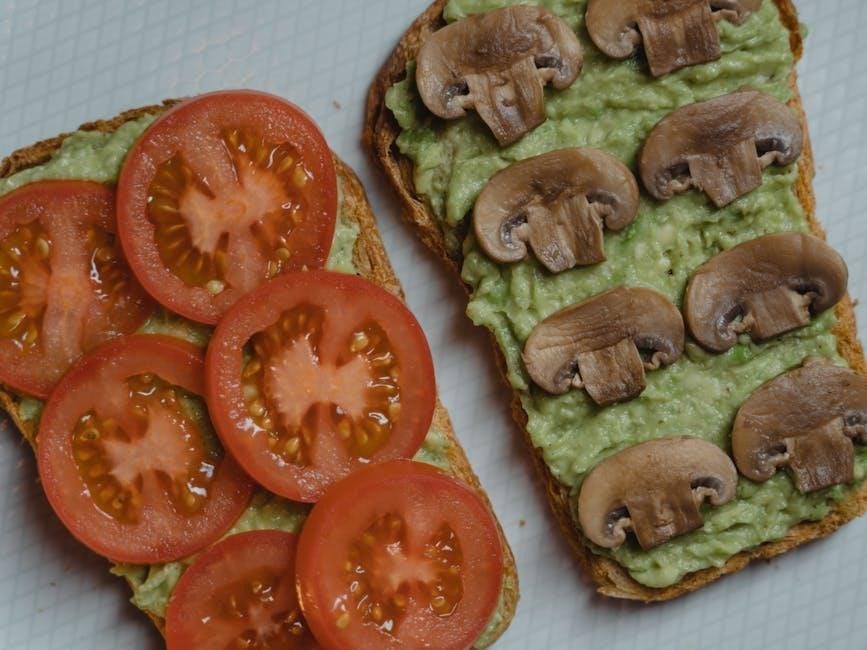Understanding Carb Cycling
Carb cycling is a dietary strategy involving alternating carbohydrate intake to optimize fat loss and performance. It’s popular among athletes and bodybuilders for enhancing results.
What is Carb Cycling?
Carb cycling is a dietary approach that involves alternating carbohydrate intake to optimize fat loss, muscle retention, and performance. It typically includes high-carb days for intense training and low-carb days for fat burning. This strategy helps manipulate carbohydrate stores and metabolic responses, making it popular among athletes and bodybuilders. The plan is customizable, allowing individuals to tailor carb intake based on their goals and activity levels. It’s not a quick fix but a structured method for achieving specific physiological outcomes.
How Carb Cycling Works
Carb cycling works by alternating carbohydrate intake to align with training intensity and recovery needs. On high-carb days, you replenish glycogen stores for energy during intense workouts. Low-carb days shift the body to burn fat for fuel, enhancing fat loss. This strategic approach manipulates carbohydrate availability to maximize performance and fat burning while minimizing muscle loss. The cycle duration varies, but the core principle remains consistent: matching carb intake to physical demands.
Types of Carb Cycling Plans
Carb cycling plans vary in structure, catering to different goals and lifestyles. Common types include daily cycling (alternating high and low carb days) and weekly cycling (clustering high and low carb periods). Some plans incorporate medium-carb days for balance. Long-term plans, like a 6-week cycle, allow for gradual adaptation. Each type tailors carbohydrate intake to specific objectives, such as fat loss or performance enhancement, ensuring flexibility and sustainability for individuals.

Benefits of a Carb Cycling Meal Plan
A carb cycling meal plan enhances fat loss, preserves muscle, and boosts performance by strategically managing carbohydrate intake.
Weight Loss and Fat Burning
Carb cycling promotes weight loss by depleting glycogen stores on low-carb days, forcing your body to burn fat for energy. High-carb days replenish energy levels, while low-carb days enhance fat oxidation. This alternating approach helps maintain metabolic balance, preventing plateaus and supporting sustained fat burning. By strategically managing carbs, you optimize your body’s ability to shed fat while preserving lean muscle, making it an effective strategy for weight loss and improved body composition.
Muscle Retention and Gain
Carb cycling helps retain and build muscle by balancing carbohydrate intake with protein. High-carb days provide energy for intense workouts, promoting muscle growth and recovery. On low-carb days, the body burns fat while maintaining muscle mass due to adequate protein intake. This balance prevents muscle breakdown and supports lean muscle gain, making it ideal for bodybuilders and athletes aiming to enhance strength and physique without sacrificing muscle tissue.
Improved Athletic Performance
Carb cycling enhances athletic performance by strategically aligning carbohydrate intake with training demands. High-carb days fuel intense workouts, preventing fatigue and boosting endurance. On low-carb days, the body efficiently burns fat for energy, improving metabolic flexibility. This balanced approach ensures sustained energy levels, supports recovery, and optimizes physical performance, making it a valuable strategy for athletes seeking to enhance their endurance and overall training effectiveness.
How to Create a Carb Cycling Meal Plan
Designing a carb cycling plan involves alternating carb intake based on training goals. Balance macronutrients, focus on whole foods, and tailor portions to individual needs for success.
High-Carb Days
High-carb days are designed to replenish glycogen stores and fuel intense workouts. Focus on complex carbs like whole grains, fruits, and vegetables. Include lean proteins and healthy fats to balance meals. Timing carbs around workouts can enhance performance and recovery. Aim for higher carb intake on training days to maximize energy and support muscle function. This phase helps maintain metabolic balance and prevents fatigue during high-intensity activities.
Low-Carb Days
Low-carb days focus on reducing carbohydrate intake to promote fat burning and metabolic adaptation. Emphasize lean proteins, healthy fats, and fibrous vegetables like spinach and broccoli. Avoid sugary foods and refined carbs; Stay hydrated and consider electrolyte supplements to prevent fatigue. These days help the body adapt to using fat as a primary energy source, enhancing weight loss and improving insulin sensitivity. Timing carb intake around workouts on low-carb days can also support performance.
Medium-Carb Days
Medium-carb days provide a balance between energy replenishment and fat burning. Typically, carb intake is reduced by 15-20% compared to high-carb days. Focus on complex carbs like whole grains, sweet potatoes, and legumes. Pair with moderate protein and healthy fats to maintain satiety. These days are ideal for active recovery or moderate-intensity workouts, helping to sustain energy levels without overloading on carbs. They also support muscle function and overall metabolic health effectively.
Timing Your Carb Intake
Timing your carb intake is crucial for optimizing results. Consume high-carb meals around high-intensity workouts to fuel performance and aid recovery. On low-intensity days, reduce carb intake and focus on protein and fats. Aim for a balanced meal with complex carbs 1-2 hours pre-workout and a post-workout shake or meal within 30 minutes. This strategy maximizes energy use and supports fat burning while maintaining muscle function and overall metabolic health effectively.
Sample 7-Day Carb Cycling Meal Plan
Here’s a structured 7-day carb cycling meal plan designed to balance energy needs with weight management goals, alternating between high, medium, and low-carb days:
- Day 1 (High-Carb, High-Intensity Training):
- Breakfast: Oatmeal with berries and a scoop of protein powder
- Snack: Apple slices with almond butter
- Lunch: Grilled chicken with quinoa and steamed vegetables
- Snack: Greek yogurt with honey
- Dinner: Salmon with sweet potato and green beans
- Day 2 (Low-Carb, Rest Day):
- Breakfast: Scrambled eggs with spinach and avocado
- Snack: Cottage cheese with raspberries
- Lunch: Turkey lettuce wraps with avocado and tomato
- Snack: Hard-boiled eggs and cherry tomatoes
- Dinner: Grilled steak with cauliflower mash and broccoli
- Day 3 (Medium-Carb, Moderate Training):
- Breakfast: Whole-grain toast with avocado and a fried egg
- Snack: Mixed nuts and a small orange
- Lunch: Chicken stir-fry with brown rice and mixed vegetables
- Snack: Protein smoothie with spinach and banana
- Dinner: Pork tenderloin with roasted Brussels sprouts and a small serving of mashed potatoes
- Day 4 (High-Carb, High-Intensity Training):
- Breakfast: Whole-grain pancakes with fresh fruit and maple syrup
- Snack: Rice cakes with peanut butter and banana slices
- Lunch: Grilled chicken wrap with whole-grain tortilla and mixed greens
- Snack: Greek yogurt with mixed berries
- Dinner: Shrimp with couscous and sautéed asparagus
- Day 5 (Low-Carb, Rest Day):
- Breakfast: Spinach omelet with feta cheese
- Snack: Mozzarella cheese sticks and raw almonds
- Lunch: Tuna salad with mixed greens and olive oil dressing
- Snack: Celery sticks with cream cheese
- Dinner: Grilled chicken breast with zucchini noodles and cherry tomatoes
- Day 6 (Medium-Carb, Moderate Training):
- Breakfast: Smoothie bowl with whole-grain cereal, banana, and almond milk
- Snack: Protein bar and a handful of mixed nuts
- Lunch: Turkey and avocado sandwich on whole-grain bread with a side salad
- Snack: Carrot sticks with hummus
- Dinner: Beef stir-fry with brown rice and mixed vegetables
- Day 7 (Low-Carb, Active Recovery):
- Breakfast: Eggs Benedict with a low-carb English muffin
- Snack: Cottage cheese with pineapple chunks
- Lunch: Grilled chicken Caesar salad with romaine lettuce
- Snack: Raw veggies with guacamole
- Dinner: Baked cod with asparagus and a side of cauliflower rice
This plan alternates between high, medium, and low-carb days, ensuring a balance of nutrients and energy for different activity levels. Adjust portions and ingredients based on personal preferences and dietary needs.
High-Intensity Training Days
On high-intensity training days, focus on consuming complex carbs for sustained energy. Include meals like oatmeal with fruit, whole-grain wraps with lean meats, and quinoa salads. Post-workout, replenish glycogen with a protein and carb-rich snack, such as a smoothie with bananas and whey protein. Balance meals with healthy fats like avocado and nuts to support recovery. Adjust portion sizes based on calorie needs and training intensity.
Low-Intensity or Rest Days
On low-intensity or rest days, reduce carbohydrate intake to promote fat burning. Focus on protein-rich meals like grilled chicken, fish, and eggs, paired with low-carb vegetables such as spinach, broccoli, and cauliflower. Incorporate healthy fats like avocado, nuts, and olive oil for satiety. Avoid sugary and processed foods to maintain metabolic balance. Hydrate adequately and consider intermittent fasting to enhance fat utilization during rest periods. Adjust portions to avoid excessive calorie consumption.

Common Mistakes to Avoid
Common mistakes include neglecting protein intake, overeating on high-carb days, and inconsistency in following the plan. Avoiding these errors ensures better results and sustainability.
Neglecting Protein Intake
Neglecting protein intake is a common mistake in carb cycling. Protein is essential for muscle repair and retention, especially during low-carb phases. Without sufficient protein, muscle loss can occur, undermining fitness goals. Ensure a moderate protein intake on both high and low-carb days to maintain muscle mass and support overall health. This balance is crucial for achieving desired results without compromising muscle structure.
Overeating on High-Carb Days
Overeating on high-carb days is a common pitfall, leading to excessive calorie intake and hindering fat loss. While high-carb days are designed to replenish energy stores, portion control is essential. Consuming more carbs than needed can result in fat storage and digestive discomfort. Moderation is key; focus on nutrient-dense carbs like whole grains, fruits, and vegetables to avoid overconsumption and maintain balance in your carb cycling plan.
How to Find the Right Carb Cycling Approach for You
Experiment with different carb cycling strategies and track progress to identify what works best for your body and goals. Seek professional guidance for personalized plans and resources like a free carb cycling meal plan PDF for structured guidance.
Experimenting with Different Strategies
Experimenting with various carb cycling patterns helps determine the most effective approach for your goals. Try alternating high-carb and low-carb days, or incorporate medium-carb days for balance. Adjust macronutrient ratios based on performance and fat loss progress. Consistency is key, so track your results to refine your strategy. Consider seeking professional guidance to tailor your plan further and explore resources like a free carb cycling meal plan PDF for inspiration and structure.
Seeking Professional Guidance
Consulting a registered dietitian or healthcare professional can help tailor a carb cycling plan to your specific needs. They provide personalized recommendations, ensuring your diet is nutritionally balanced and aligned with your goals. Professional guidance also helps monitor progress and adjust the plan as needed. This expertise can enhance results and minimize potential side effects. Additionally, many professionals offer meal plan PDFs, making it easier to follow structured advice for optimal outcomes.

Tracking Progress and Adjusting Your Plan
Regularly monitor your weight, body fat, and energy levels to assess your carb cycling plan’s effectiveness. Adjust your carb intake or exercise routine based on progress.
Monitoring Weight and Body Fat
Regularly tracking your weight and body fat percentage helps assess the effectiveness of your carb cycling plan. Weekly measurements provide insights into how your body responds to carbohydrate fluctuations. This data is crucial for making informed adjustments to your diet and training. Consistent monitoring ensures you stay on track toward your goals, whether it’s fat loss or muscle retention. Accurate tracking also helps identify plateaus early, allowing timely modifications to your plan.
Adjusting Carb Intake Based on Results
Monitor your weight, body fat, and performance regularly. If weight loss stalls, consider reducing carb intake on low-carb days or increasing activity levels. Conversely, if performance suffers, you may need to increase carbs on high-intensity training days. Adjustments should be gradual, allowing time to assess their impact. Tailoring your carb intake ensures long-term success and keeps your body responsive to the plan. Consistent evaluation helps refine your approach for optimal results.

Bonus: Free Carb Cycling Meal Plan PDF
Download a free carb cycling meal plan PDF to kickstart your journey. This structured guide offers a 7-day plan with high, low, and medium-carb days. Designed for ease, it includes breakfast, lunch, dinner, and snack options. Perfect for those new to carb cycling, it helps maintain consistency and variety. Customize the plan based on your goals and preferences to maximize results and stay motivated. A valuable resource for achieving success with carb cycling!